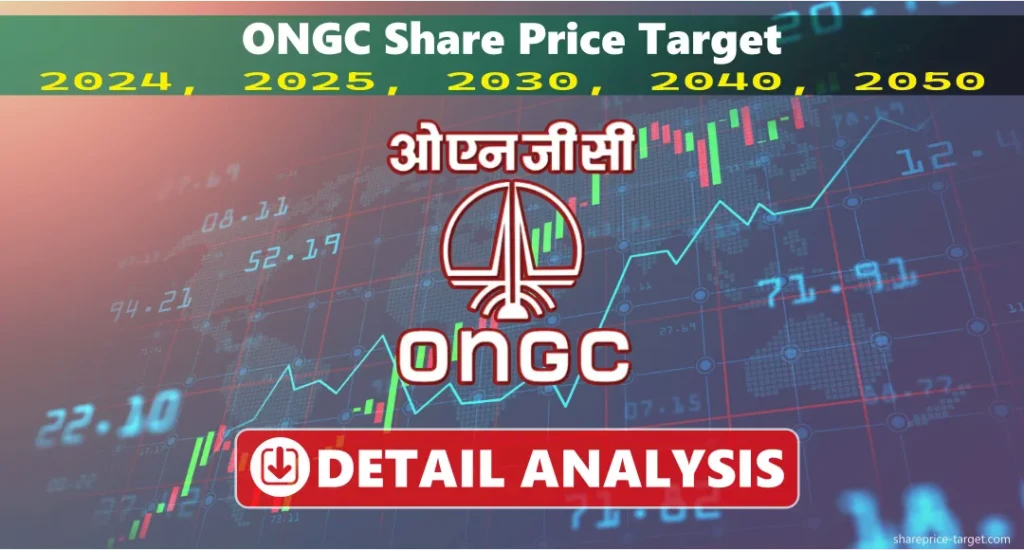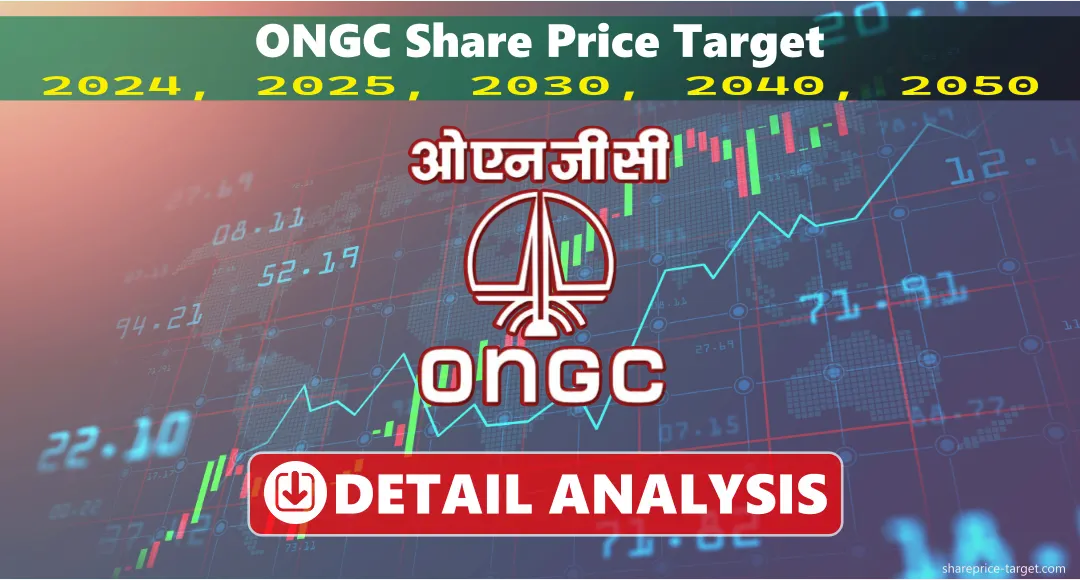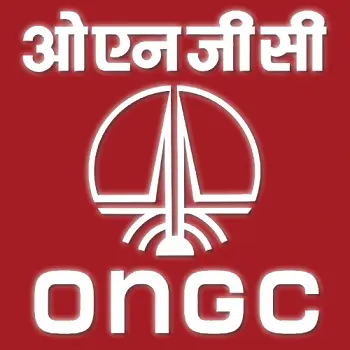ONGC Share Price Target 2025, 2026, 2030, 2040, 2050
Oil and Natural Gas Corporation Limited is India’s biggest crude oil and natural gas business, vital to the energy industry. Many investors and market experts are intrigued about this state-owned enterprise’s future share price goals.
ONGC share price projections for 2024, 2025, 2030, 2040, and 2050 are examined in light of several variables that may affect its stock performance.
- 1 What is Oil and Natural Gas Corporation Ltd NSE: ONGC?
- 2 ONGC Share Price
- 3 ONGC Share Price Target 2025
- 4 ONGC Share Price Target 2026
- 5 Share Price Target 2027
- 6 Share Price Target 2028
- 7 Share Price Target 2029
- 8 ONGC Share Price Target 2030
- 9 Share Price Target 2040
- 10 Share Price Target 2050
- 11 Should I buy ONGC stock?
- 12 Oil and Natural Gas Corporation Earning Results
- 13 Expert Forecasts on the Future of Oil and Natural Gas Corporation
- 14 Is ONGC stock good to buy? (Bull case & Bear case)
- 15 Conclusion
- 16 FAQs
What is Oil and Natural Gas Corporation Ltd NSE: ONGC?
ONGC is an Indian multinational crude oil and gas business. Founded in 1956, it is a government agency under the Ministry of Petroleum and Natural Gas. ONGC explores and produces crude oil, natural gas, and value-added products. Through ONGC Videsh, ONGC engages throughout the hydrocarbon value chain locally and abroad.
The global oil market should remain stable, which will allow this company to generate good revenue. The company is focusing on increasing its oil production, while also working on improving its technology and reducing costs, which will help it earn more profits. It is expanding in both local and international markets and is looking for new areas to explore for oil and gas. The company is forming strong partnerships with global energy companies, which will help it grow further. As it continues to improve its operations and exploration, its share price is expected to rise. In 2025, its share price target would be ₹365, as per our analysis.
By our prediction, its share price will be between ₹175 and ₹365 in 2025.
| Year | Minimum Price (Rs) | Maximum Price (Rs) |
| 2025 | 175 | 365 |
| Month | Minimum Price (Rs) | Maximum Price (Rs) |
| January | 236 | 273 |
| February | 223 | 263 |
| March | 200 | 265 |
| April | 187 | 270 |
| May | 175 | 283 |
| June | 191 | 290 |
| July | 198 | 299 |
| August | 200 | 310 |
| September | 210 | 324 |
| October | 230 | 338 |
| November | 212 | 347 |
| December | 220 | 365 |
The company is expected to discover new oil and gas reserves, which will lead to higher production and better profits. Natural gas is becoming a more important energy source, and this company is investing more in gas projects, which will contribute to the company’s overall growth. At the same time, it is also investing in renewable energy projects, such as solar and wind, which will help it diversify and stay ahead in the energy market. As the company continues to grow its mix of oil, gas, and renewable energy, it will likely see an increase in its share price. In 2026, its share price target would be ₹480 as per our analysis.
By our analysis, its share price would be between ₹200 to ₹480 in 2026.
| Year | Minimum Price (Rs) | Maximum Price (Rs) |
| 2026 | 200 | 480 |
| Month | Minimum Price (Rs) | Maximum Price (Rs) |
| January | 258 | 388 |
| February | 280 | 308 |
| March | 200 | 230 |
| April | 218 | 265 |
| May | 250 | 288 |
| June | 273 | 298 |
| July | 280 | 308 |
| August | 297 | 329 |
| September | 310 | 358 |
| October | 342 | 388 |
| November | 365 | 449 |
| December | 428 | 480 |
The global demand for oil and natural gas is expected to keep increasing, especially in developing countries, and this company is in a good position to benefit from this. The company’s ongoing efforts to discover new reserves and improve its exploration techniques will help increase its production. It is also investing in new technologies that make its production processes more efficient, which will improve its profit margins. As the company focuses more on renewable energy sources, such as wind and solar, it will become more competitive in the market. In 2027, its share price target would be ₹602 as per our prediction.
Its share price would be between ₹300 to ₹602 in 2027, as per our analysis.
| Year | Minimum Price (Rs) | Maximum Price (Rs) |
| 2027 | 300 | 602 |
| Month | Minimum Price (Rs) | Maximum Price (Rs) |
| January | 428 | 510 |
| February | 390 | 418 |
| March | 350 | 375 |
| April | 338 | 356 |
| May | 300 | 354 |
| June | 338 | 378 |
| July | 360 | 390 |
| August | 378 | 430 |
| September | 390 | 478 |
| October | 428 | 560 |
| November | 490 | 580 |
| December | 560 | 602 |
The company is likely to see more profits due to an increase in oil and gas production from discoveries. Additionally, its investments in renewable energy projects will start to pay off, bringing in extra income. As the world moves toward cleaner energy, its natural gas production will play a larger role, and demand for it is expected to grow. The company’s strategy to balance its traditional energy operations with renewable energy sources will help it continue performing well in a changing market. As its operations and profits grow, its share price should keep rising. In 2028, its share price target would be ₹745 as per our analysis.
By our analysis, its share price would be between ₹409 to ₹745 in 2028.
| Year | Minimum Price (Rs) | Maximum Price (Rs) |
| 2028 | 409 | 745 |
| Month | Minimum Price (Rs) | Maximum Price (Rs) |
| January | 560 | 612 |
| February | 521 | 550 |
| March | 480 | 511 |
| April | 452 | 470 |
| May | 409 | 450 |
| June | 438 | 478 |
| July | 461 | 560 |
| August | 489 | 590 |
| September | 546 | 630 |
| October | 590 | 675 |
| November | 643 | 710 |
| December | 690 | 745 |
Its share price is expected to increase even further. Global energy demand is rising, and it is well-positioned to take advantage of this due to its large production capacity. The company’s expansion into new markets, both at home and abroad, will also help boost its growth. Additionally, its growing investments in green energy, like solar and wind, will support its long-term growth. In 2029, its share price target would be ₹860 as per our prediction.
Its share price would be between ₹522 to ₹860 in 2029, as per our analysis.
| Year | Minimum Price (Rs) | Maximum Price (Rs) |
| 2029 | 522 | 860 |
| Month | Minimum Price (Rs) | Maximum Price (Rs) |
| January | 690 | 766 |
| February | 654 | 690 |
| March | 610 | 650 |
| April | 555 | 590 |
| May | 522 | 570 |
| June | 554 | 610 |
| July | 589 | 646 |
| August | 625 | 680 |
| September | 658 | 720 |
| October | 680 | 760 |
| November | 745 | 810 |
| December | 788 | 860 |
This company is expected to become even stronger in the energy market. The company’s efforts to reduce its carbon emissions and improve energy efficiency will make it a more attractive option for investors. It is also focused on adopting new technologies to improve oil and gas production, lowering its costs and increasing its profits. As the company moves forward with its clean energy goals, the combination of these efforts will give steady growth. In 2030, its share price target would be ₹960 as per our analysis.
By our analysis, its share price would be between ₹650 to ₹960 in 2030.
| Year | Minimum Price (Rs) | Maximum Price (Rs) |
| 2030 | 650 | 960 |
| Month | Minimum Price (Rs) | Maximum Price (Rs) |
| January | 788 | 878 |
| February | 732 | 755 |
| March | 690 | 730 |
| April | 650 | 700 |
| May | 687 | 730 |
| June | 708 | 756 |
| July | 730 | 775 |
| August | 756 | 790 |
| September | 775 | 810 |
| October | 790 | 870 |
| November | 856 | 930 |
| December | 918 | 960 |
It made investments in renewable energy sources like solar, wind, and hydrogen, which will support its growth. The company’s focus on reducing its carbon footprint and producing cleaner energy will help it stay competitive in an energy market that is becoming more environmentally conscious. As it expands into global energy markets, especially in countries with growing energy needs, its revenue will continue to rise. With an increasing global demand for energy and ONGC’s focus on green energy, its share price is expected to continue rising. In 2040, its share price target would be ₹2266 as per our prediction.
Its share price would be between ₹1720 to ₹2266 in 2040, as per our analysis.
| Year | Minimum Price (Rs) | Maximum Price (Rs) |
| 2040 | 1720 | 2266 |
| Month | Minimum Price (Rs) | Maximum Price (Rs) |
| January | 1720 | 1788 |
| February | 1750 | 1800 |
| March | 1778 | 1810 |
| April | 1790 | 1823 |
| May | 1808 | 1854 |
| June | 1826 | 1875 |
| July | 1854 | 1930 |
| August | 1875 | 1976 |
| September | 1946 | 2021 |
| October | 1990 | 2189 |
| November | 2078 | 2230 |
| December | 2190 | 2266 |
The company’s focus on green technologies, such as hydrogen production and carbon capture, will make it a leader in the energy industry. The company will continue adapting to the world’s shift towards cleaner energy while maintaining its position as a major oil and gas provider. As it invests in new technologies and renewable energy, its strong focus on sustainability will help it grow and stay competitive. The company’s energy portfolio will lead to substantial growth in its share price. In 2050, its share price target would be ₹4160 as per our analysis.
By our analysis, its share price would be between ₹3625 to ₹4160 in 2050.
| Year | Minimum Price (Rs) | Maximum Price (Rs) |
| 2050 | 3625 | 4160 |
| Month | Minimum Price (Rs) | Maximum Price (Rs) |
| January | 3625 | 3687 |
| February | 3656 | 3730 |
| March | 3690 | 3765 |
| April | 3732 | 3780 |
| May | 3755 | 3860 |
| June | 3788 | 3878 |
| July | 3820 | 3890 |
| August | 3865 | 3925 |
| September | 3890 | 4056 |
| October | 3946 | 4089 |
| November | 4036 | 4130 |
| December | 4102 | 4160 |
Should I buy ONGC stock?
| Year | Minimum Price (Rs) | Maximum Price (Rs) |
| 2025 | 175 | 365 |
| 2026 | 200 | 480 |
| 2027 | 300 | 602 |
| 2028 | 409 | 745 |
| 2029 | 522 | 860 |
| 2030 | 650 | 960 |
| 2040 | 1720 | 2266 |
| 2050 | 3625 | 4160 |
When investing in ONGC, examine the pros and downsides. To aid your judgment, consider these data: ONGC’s recent financial performance has been excellent. The company revenue increased 17.2% from ₹4,53,461 crore in FY2021 to ₹5,31,315 crore in FY2022. Net profit increased significantly from ₹11,246 crore to ₹40,306 crore during the same time. Income-focused investors like ONGC 4.09% dividend yield. The company’s 0.45 debt-to-equity ratio implies financial stability and a robust balance sheet. Investors should also examine global oil price volatility and ONGC profitability. The company’s success depends on worldwide crude oil prices, which fluctuate owing to geopolitical and economic factors.
Oil and Natural Gas Corporation Earning Results
| Quarter | Revenue (₹ Cr) | Net Profit (₹ Cr) | EPS (₹) |
| Q1 FY2024 | 1,67,276 | 9,936 | 7.90 |
| Q4 FY2023 | 1,59,282 | 10,015 | 7.96 |
| Q3 FY2023 | 1,58,128 | 11,045 | 8.78 |
| Q2 FY2023 | 1,51,846 | 12,826 | 10.20 |
Fundamental Table
| Metric | Value |
| Market Cap | ₹376,548 Crore |
| P/E Ratio | 8.38 |
| Book Value | ₹244.23 |
| Dividend Yield | 4.09% |
| ROCE | 19.12% |
| ROE | 15.70% |
| Debt to Equity | 0.45 |
| Promoter Holding | 58.89% |
| EPS (TTM) | ₹35.76 |
Key Metrics
| FY PE Ratio | PB Ratio | Dividend Yield |
|---|---|---|
| 7.53 | 1.02 | 4.16% |
| Sector PE | Sector PB | Sector Div Yld |
|---|---|---|
| 13.81 | 1.80 | 1.86% |
Peers & Comparison
| Stock | PE Ratio | PB Ratio | Dividend Yield |
|---|---|---|---|
| Oil and Natural Gas Corporation Ltd | 7.53 | 1.02 | 4.16% |
| Oil India Ltd | 15.80 | 1.90 | 1.57% |
| Hindustan Oil Exploration Company Ltd | 13.74 | 2.65 | — |
| Asian Energy Services Ltd | 64.79 | 8.27 | — |
Expert Forecasts on the Future of Oil and Natural Gas Corporation
Industry analysts are divided about ONGC’s future. Analysts like the company’s production increases and oil and gas field exploration. They say ONGC’s local solid footprint and worldwide development via ONGC Videsh position it for growth. Some experts worry about fossil fuel-based firms’ long-term survival in light of the worldwide drive toward renewable energy. They stress that ONGC must diversify and invest in sustainable energy to be competitive in the shifting energy scenario.
Many observers agree that ONGC’s strong market position and government support provide some stability despite energy transition concerns. However, the company’s long-term success depends on its exploration activities and capacity to adapt to shifting energy dynamics.
Is ONGC stock good to buy? (Bull case & Bear case)

Bull Case:
- Strong oil and gas market position in India
- Regular dividends and high-yield
- Government support and energy security strategy for India
- New oil and gas finds might boost output.
- Low value relative to peers internationally
Bear Case:
- Global oil price volatility vulnerability
- Focusing on renewable energy may affect fossil fuel consumption.
- Intervention by the government in pricing and investment
- Possible environmental and regulatory issues
- Domestic private sector competition
Conclusion
ONGC’s share price will depend on its ability to adapt to the shifting energy environment, control costs, and seize fresh exploration possibilities. The corporation’s worldwide transition toward renewable energy challenges it, but its strong market position and strategic relevance to India’s energy security give it a stable basis.
The unpredictable oil and gas business should be weighed against the prospect of regular dividend income from ONGC. Those interested in India’s energy industry and the company’s capacity to adapt may like the stock. Before investing in ONGC or any other stock, you should study, consider your financial objectives and risk tolerance, and speak with a financial professional.








